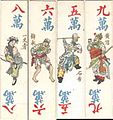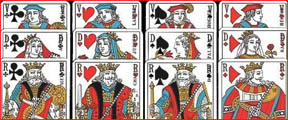Trifecta®Poker is based on a Trifecta of winning Horse Cards as Win, Place, and Show.
A Trademarked blend of Horse Racing, Classic Poker games and all original Artwork.
A BASIC HISTORY OF PLAYING CARDS AND THE EVOLUTION OF THE GAME OF POKER
Playing cards were invented in ancient China. They were found in China as early as the 9th century during the Tang Dynasty (618–907). The first reference to card games in world history dates from the 9th century. By the 11th century, playing cards could be found throughout the Asian continent. During the Ming Dynasty (1368–1644), characters from popular novels were widely featured on the faces of playing cards.

The designs on modern Mahjong tiles likely evolved from those earliest playing cards. However, it may be that the first deck of cards ever printed was a Chinese domino deck, in whose cards all 21 combinations of a pair of dice are depicted.
Playing cards first entered Europe in the late 14th century by the way of the Silk road that began with the travels of Marco Polo. The first documentary evidence of their use is in Bern, Switzerland in 1367. Wide use of playing cards in Europe can, with some certainty, be traced from 1377 onwards.
In the late 14th century, the use of playing cards spread rapidly throughout Europe. Documents mentioning cards date from 1371 in Spain, 1377 in Switzerland, and 1380 in many locations including Florence and Paris.
 In the 15th century in Europe, the suits of playing cards varied: typically a deck had four suits, although five suits were common and other arrangements are also known. Italian and Spanish cards of the 15th century used swords, batons, cups, and coins. The Tarot, which included extra trump cards, was invented in Italy in the 15th century.
In the 15th century in Europe, the suits of playing cards varied: typically a deck had four suits, although five suits were common and other arrangements are also known. Italian and Spanish cards of the 15th century used swords, batons, cups, and coins. The Tarot, which included extra trump cards, was invented in Italy in the 15th century.
The four suits now used in most of the world — spades, hearts, diamonds, and clubs — originated in France in about 1480. Also in the 15th century, Europeans changed the court cards to represent European royalty and attendants, originally "king", "chevalier" (knight), and "knave".
 Court cards designed in the 16th century in the manufacturing centre of Rouen became the standard design in England, while a Parisian design became standard in France.
Court cards designed in the 16th century in the manufacturing centre of Rouen became the standard design in England, while a Parisian design became standard in France.
The United States introduced the joker into the deck. The design of the joker and its function are almost identical to the Fool from the original French Tarot deck, which had been removed in the transformation to the standard 52-card French deck.
 In the 15th century in Europe, the suits of playing cards varied: typically a deck had four suits, although five suits were common and other arrangements are also known. In Germany, hearts, bells, leaves, and acorns became the standard suits and are still used in Eastern and Southeastern German decks today. Italian and Spanish cards of the 15th century used swords, batons, cups, and coins. The Tarot, which included extra trump cards, was invented in Italy in the 15th century.
In the 15th century in Europe, the suits of playing cards varied: typically a deck had four suits, although five suits were common and other arrangements are also known. In Germany, hearts, bells, leaves, and acorns became the standard suits and are still used in Eastern and Southeastern German decks today. Italian and Spanish cards of the 15th century used swords, batons, cups, and coins. The Tarot, which included extra trump cards, was invented in Italy in the 15th century.
The four suits now used in most of the world — spades, hearts, diamonds, and clubs — originated in France in about 1480. In England, the French suits were eventually used, although the earliest decks had the Italian suits.
One of the most prominent and very simple versions of the game was basic Stud Poker, but other ideas were developed by inventive players and also became popular, including 5 Card,7 Card Stud, and also Omaha and Texas Hold‘em.
Texas Hold‘em, now the most popular game, began during the 1970’s when it became a featured entertainment draw as the main high stakes game in the televised World Series of Poker.
Now we have Trifecta Poker,a whole new generation of playing cards with all Face cards and no Royalty.
Trifecta Poker is an entirely American game invented in Texas.
Trifecta Poker represents the individuality of America and the free spirit to be a winner. If, of course, you hold the right combination!